Land of Living Legends: 2019 Madagascar Diaries #3
Republishing my blog posts from my time as a volunteer research assistant in Kianjavato, Madagascar, in mid-2019
Background: from late July through mid-October 2019, I worked as a volunteer research assistant for the Madagascar Biodiversity Partnership (MBP), based out of the Kianjavato Ahmanson Field Station (KAFS). KAFS is located near the village of Kianjavato, in the eastern rainforests of Madagascar. During this time, I worked to assist MBP’s studies of the critically endangered greater bamboo lemur (Prolemur simus), as well as teaching English classes and later assisting the community reforestation program.
I wrote a series of “from the field” blog posts describing my life and work there as it happened, from a first-person “you are there” perspective. I’m now republishing excerpts from these on Substack!
Here follows a chronicle of my last week as the volunteer research assistant for the Prolemur simus team. It’s also, not coincidentally, about the halfway point of my time in Madagascar-I arrived July 22nd, and I’ll be leaving October 16th [2019]. Until then, I’ll be learning a whole about a whole new aspect of MBP’s incredible work as a volunteer research assistant for the Reforestation team!
alatsinainy, aogositra enina amby roapolo (Monday, August twenty-sixth)
On Monday, we tracked Max, dominant male of the East Two group. He conducted the usual morning round of rest/eat bamboo/drink from ravenala flowers/chase around a few of his groupmates/rest again/awake and repeat, like the majority of lemurs I’ve followed have done. Prolemur simus are cathemeral, meaning they’re not nocturnal, diurnal or crepuscular (active around dawn and dusk) but active and resting in briefer, alternating spurts during both the day and the night. It was a pleasure to share a little of their peaceful, meditative-seeming rhythm, and imagine what it must be like to live among the pothos vines, ravenala trees and bamboo shoots, eating leaves and sipping nectar. I can’t quite recall, but I believe it was Clara Barton who said that one reason she worked as a nurse on the battlefield was that an entire worldview and mental landscape died with every fallen soldier. Losing this critically endangered species, or any such, would be far worse: an entire interlocking piece of the universe would have fallen out, a species’ life-perspective, a modus vivendi as a key part of a unique ecosystem.
Near the end of the follow, I was further privileged to get an excellent view of Hopper grooming herself while sitting in a tree. The varibolomavo matriarch was as flexible as a lemuriform yogi, stretching her legs beside her head like a cat and holding her tail in her very human-like hands. The greater bamboo lemurs of Sangasanga are eternally fascinating, enchanting creatures, and I will always be honored to have been able to witness a portion of their lives.
Another particularly interesting event that day occurred a little earlier than Hopper’s grooming session, while Hery, Mamy, and I stood under interlacing stalks of bamboo watching the lemurs feed. We were having a great time exchanging English and Malagasy vocabulary and chatting, when Hery pointed out to me a near-invisible tanalahy, or chameleon, on the stalk of an understory plant. It was the first chameleon I had seen in Madagascar (in addition to lemurs, tenrecs, euplerids, and everything else, this country is home to most of the world’s chameleon species!) and I was greatly excited. I took a boatload of pictures, and even held it in my hand for a little while when it scampered off the branch. Later, with the aid of iNaturalist and a KAFS guide to Malagasy reptiles, I determined that it was Calumma nasutum, the aptly named nose-horned chameleon. The guide mentioned that although it was listed as one species for now, it was probably actually a “species complex” of several similar chameleons. That set me thinking about Linnaean taxonomy, that amazingly useful system of assigning all life-forms a Latin binomial name indicating their genus and species, in order to enable scientists speaking different vernacular languages to have a common referent. It was a little foreshadowing of the taxonomical wunderkind I was to encounter that Wednesday.
talata, aogositra fito amby roapolo (Tuesday, August twenty-seventh)
On Tuesday, I joined Mamy and Marolahy in the field to follow Rufiface, dominant male of the Northwest Two group, consort of Phoenix, and father of Ghost. He spent a good deal of time in a beautiful little hillside area, where pothos vines made the tree trunks look like massive green flamboyant Corinthian columns in some immense temple. We also got a great view of the endlessly photogenic Ghost eating bamboo! (pictured).
Once we left the forest, I waited for about thirty minutes in the streets of Kianjavato for the other team to return. At that point, we could collect their gear and call the MBP van to pick us up. During that time, we had some rather interesting cultural experiences. First, I said hello to two Malagasy police officers, Rija and Njaka. They were very polite and friendly gentlemen, practiced their English with us, and kindly brought out a bench from their station for us to sit on. I showed them some lemur pictures on my phone (my customary practice when chatting with local citizens, in the spirit of drumming up interest in conservation), and they expressed a wish to go into the forest to see them. I said I’d have to consult my superiors. After conversation flagged a bit, we got a reminder of some of the darker aspects of the milieu in which we were living and working. I hadn’t seen that much of it yet, most of my time being spent either at KAFS or in the forest, but I knew this was an area of grinding poverty, even by Malagasy standards.
A study by a Harvard public health scientist on Kianjavato Commune had found that nearly everyone was primarily a subsistence farmer, the average household income was 50,000 ariary a year, or about US $22, and 20% of children were malnourished to the point of stunted growth. That day, as we sat on the bunch, a small child, perhaps five or six, came up to us. He (I think) was barefoot, and naked except for a single pair of ripped and tattered red synthetic workout shorts. He had a thin frame, but a swollen belly, which I seem to recall is an indicator of the presence of intestinal parasites. He couldn’t speak any English, and didn’t even say much in Malagasy, but his outstretched hand conveyed a message in a universal language: give me something, anything. We didn’t. What seemed most incredible to my mind, in a way, was how little taking no action bothered me. Had I been presented with a barefoot, near-naked, hungry preschool-aged child begging for money a few months ago, in America, I would have taken them by the hand and called the police, or Social Services, and would not have rested until I had done something to remediate their position. But here, the police were ten feet away and unconcerned, and it was entirely possible, even likely, that this child was by local standards perfectly well cared for, fed as much as a subsistence rice paddy and vegetable garden could provide and given as much healthcare as an income of $22 a year could afford. I said “Miala tsiny,” (I’m sorry), and we left the child to wander away.
After lunch, I read “Rewilding Complex Ecosystems,” from Science magazine’s Tomorrow’s Earth series, on my phone. It was a fascinating paper, describing instances of rewilding from Switzerland, Germany, Brazil, and the famous Chernobyl Exclusion Area of Ukraine. The writers described rewilding as characterized by “active non-management,” i.e. allowing ecological processes to reestablish themselves on their own, aided only by reintroduction of preexisting factors, such as animal species and unregulated river flow. The writers also posited the idea of quantifying rewilding in terms of three factors vital to ecosystem health: stochastic disturbance (sporadic events like storms, wildfires, floods, and droughts being “permitted” to change ecological dynamics), dispersal (wildlife subpopulations maintaining gene flow and avoiding genetic drift and inbreeding by being able to move between subpopulation), and trophic complexity (a full complement of species at all major trophic levels, from primary producers like clover to tertiary consumers like wolves). When the random permutations of cellular data coverage smile upon us, there is often quite decent Internet access at KAFS, though it seems to take ages to send e-mails or download videos. I was extremely grateful that I was favored with access to this paper, as it was highly interesting and relevant to MBP’s work in Madagascar, and to land management around the world. It’s available at science.sciencemag.org/content/364/6438/eaav5570, for those who are interested.
Shortly thereafter, the Prolemur simus team was favored by an unexpected gift that met a long-felt need. Two critical classes of our team’s gear-the Automated Tracking Systems (ATS) which monitor the lemurs’ radio collars and the GPS units that allow us to log the locations at which we find them-run only on batteries. Batteries are scarce in Madagascar, as they must be imported from other nations. Even those tend to be unreliable: in one memorable experience, I personally bought a two-pack of an unfamiliar brand of Chinese batteries for a battery-less team GPS, only to find that they were as nonfunctional as cylindrical stones. But that afternoon, as University of Calgary graduate student Pamela Narvaez was preparing to leave, she gave us a plastic bag full of no less than sixty batteries left over from her camera trap research project, proper Western-bought fully functional Duracells. To my mind, used to scrounging and reusing two or three batteries at a time and getting eight new batteries a week or so, this was a positive treasure chest, a bonanza, manna from heaven. Thank you, Pamela!
alarobia, aogositra valo amby roapolo (Wednesday, August twenty-eighth)
Wednesday, though I did not know it at the time, was my last day in the field as a volunteer. I accompanied Berthin and Hery on a follow of Phoenix, mother of Ghost and matriarch of Northwest Two. I say follow, but, unusually, it involved no actual following, being in point of fact more of a “locate and wait.” Phoenix did not move from her resting position in a tree for the entire four-hour period, except for one brief moment when she shared a grooming session with her daughter, Ghost. Her immobility was so absolute as to be positively majestic. I managed to get a clear picture of her distant form through my binoculars, and was struck by the resemblance to a giant Tribble from Star Trek, a single apparently featureless undulating ball of brown fur.
On the way there, we had seen in the forest a river redgum: a tree species in the genus Eucalyptus, introduced from Australia. Hery said that the people of Kianjavato made a tea of the sweet-smelling leaves as a tonic against certain illnesses, another example of an introduced species doing good. The encounter set me thinking about the landscape of Sangasanga Mountain. It’s a quintessentially Anthropocene landscape, every aspect of it shaped by humans. Sangasanga is a forest fragment surrounded by villages and farms, much of it-indeed, most of it-consisting not of old-growth rainforest but of savoka, second-growth forest sprung up over former farmland. The entrance was on land owned by FOFIFA, an old state-owned coffee plantation, and there were still a few abandoned agricultural buildings and pipes scattered in the forest among the lemurs’ feeding sites. Humans are in and out all the time: bamboo gatherers, medicinal plant prospectors, lemur researchers. Occasionally, depending on the location of the group and the time of day, you can hear the noise of cars in the village street below while gazing at wild critically endangered lemurs. A cognitive dissonance if ever there was one. And, of course, in addition to the endemic ravenala, sandramy, and vohampika trees (and many more local species), there are introduced plants everywhere: soapbush, jackfruit, golden bamboo, and river redgum in the forest, and cosmopolitan flowers like blue porterweed (some of that grows near my house in Maine!) in open spaces. Classic descriptors of environmentally valuable land like “pristine,” “untouched,” or even “natural,” do not apply to Sangasanga. But it’s as precious and worth protecting as any piece of land in the world: home to two critically endangered lemur species (Prolemur simus and Varecia variegata), the endangered aye-aye, several other lemurs, birds from the crested drongo to the vasa parrot, reptiles from leaf-tailed geckos to nose-horned chameleons, and a plethora of other uniquely Malagasy treasures. This isn’t even a protected area under the IUCN definition-it’s town land, owned by the Kianjavato Commune (and some by FOFIFA). It’s being managed by these entities, with the guidance of MBP, in a wise and far-seeing manner: not to reach some idealized state, some human-decided archetype of what a Malagasy rainforest should be, but to protect what is there, the complex mixed-use species-rich landscape of Sangasanga (a portion of which is pictured, above). The fact that these critically endangered lemurs I have come to love can survive and thrive here, not under armed guard but by consent of their human neighbors, is less a spark than a lighthouse of hope for the besieged biota of Madagascar, and a model of human-wildlife coexistence in the Anthropocene.
I also got the chance that day in Sangasanga Forest saw to see a new one of Madagascar’s endemic living legends. At about 11 AM or so, Berthin and Hery told me that they saw a bird, and after a long sequence of their pointing it out and my failing to see it (I apologized for my “maso vazaha,” or “foreigner eyes”), I discerned the outline they were pointing to at last. I focused my binoculars on it, and found that it was a large, rather stout-looking light gray bird, with a fine wide breast and head, perched on a branch. For some indescribable reason, possibly in the gravity of its attitude as it sat perched there, it put me in mind of a small, gray penguin. “Vanga?” I asked, referencing the endemic Malagasy family of vanga birds. “No,” Hery said, shaking his head. “Cuckoo-roller.” My heart leapt within me, a burst of pure excitement. A cuckoo-roller! I had read of this unique creature, endemic to Madagascar and the nearby Comoros Islands, before I came to the country, and I was entranced at the thought that I was seeing it in the flesh. Cuckoo-rollers (Leptosomus discolor, not closely related to rollers or cuckoos), are an ancient and unique lineage, a life-form with no very close living relatives, a long, slender, unbranching twig on the tree of life. They are the only species in the genus Leptosomus (although some think that local forms of the cuckoo-roller on some of the nearby Comoros Islands deserve species status). This is not so unusual, but what is unusual is that Leptosomus is the only genus in the family Leptosomidae. For comparison, humans share the family Homininidae with seven other species of great apes (bonobos, chimpanzees, two gorilla species, and three orangutan species), and some families, such as the passerine birds (including all small “songbirds”), have hundreds of species. Beyond even this, in a recent taxonomic reorganization of birds, the scientific consensus placed the cuckoo-roller in its own taxonomic order (previously it had shared one with kingfishers and others), the other Leptosomiformes. A species alone in its order, by all the gods! Other taxonomic orders of vertebrates include such unique lineages as the Primates (all humans, apes, monkeys, and lemurs), the Sphenisciformes (penguins), and the Carnivora (lions, tigers, bears, weasels, raccoons, and nearly every other mammalian predator). The cuckoo-roller is as if there was only one species of penguin, one mammalian carnivore, and one monkey, lemur, or ape alive in the world. It is sui generis, a bird unique unto itself.
Besides its taxonomy, cuckoo-rollers are known to be highly sexually dimorphic (my cuckoo-roller was gray, and so a male: the females are brown speckled with white spots). They are carnivorous, eating large invertebrates, especially from the orders Orthoptera (grasshoppers, crickets, and katydids), Hemiptera (“true bugs” like cicadas) and Coleoptera (beetles) as well as small vertebrates like chameleons and leaf-tailed geckos. While fairly common in Malagasy forests, they still retain a certain air of mystery, having been the object of little scientific study. Helm Field Guides’ Birds of Madagascar (from the KAFS library, at my elbow as I write) states of the cuckoo-roller, “Biological knowledge remarkably scant for a species of such exceptional interest.” I contributed my little bit to that knowledge by uploading my cuckoo-roller pictures and geotag (obtained by pressing my phone’s camera to my binocular lenses, and holding the lot steady) to iNaturalist, where they will be available to all for decades to come.
Once home, I entered Phoenix’s data and enjoyed a lunch of rice and voanjobory, a delicious Malagasy groundnut rather like giant chickpeas with a hint of peanut flavor. In the afternoon, I had a rather interesting hour or so when a few of the many threads running through life at KAFS became a bit tangled. At about 2:50, I was preparing for my English class at 3, and ran over to the dining hall to retrieve my whiteboard and marker. Just then, Theoluc, leader of the Prolemur simus team and my incredibly awesome and hardworking boss, arrived at KAFS. He needed to send an email report filling in some details about darting Snow, in Vatovavy, to change the batteries in his radio collar (an operation which had occurred earlier that week, and at which foreigners were not permitted). He also needed an extra GPS for monitoring in a different site, Ambodibonary, for tomorrow. This was all perfectly reasonable and in the best interests of the project, and it was my job as a volunteer research assistant to assist. Yet I had an English class waiting for me that I had committed to teach, and I didn’t want to let them down-sending emails took ages. As I pondered this, I fumbled my marker and dropped it into a pile of duck poop, left there by some of KAFS’ wandering waterfowl. As I cleaned it off at the bucket/sink of the dining hall, Pamela (she of the battery munificence) dropped by with an interesting comment. “Oh, you’ll need to move your English class. There’s an aye-aye in a cage over there, I think they brought it in last night and they’re waiting to change the batteries in its radio collar.” (They had indeed, and the aye-aye was released back into the wild by the aye-aye team that night, ready to transmit more data for its species). Devin, another graduate student and Pamela’s partner on camera trap research, chimed in. “Don’t tell anyone, I think it’s a bit of a secret for now, by the way.” My mind boggled. Immediate and urgent lemur team needs, an English class awaiting, markers in duck poop, and now a totally unexpected clandestine aye-aye…if this was spread out over an afternoon, I could handle it easily, but arriving in the same ten minutes it was a bit much.
I took prompt action. I resolved that my primary priority was assisting Theoluc: that was my job, after all. I walked past the English class on my way to the KAFS building, and ascertained with Dominic, manager of the KAFS station proper, that the aye-aye was to be left alone but was not in fact a secret: the class could be conducted as long as we kept our voices down so as not to wake the nocturnal lemur. (Pictured: KAFS at dawn). This still left the problem of how to conduct the class. Time was a-wasting, Devin was nearby, and I’m afraid I rather put her on the spot a bit. “Are you ready to be a substitute teacher?” I asked. She looked surprised. “Um…I’m not prepared, and I don’t speak Malagasy…” “No worries. We’ve done numbers and colors in English. Just write out the numerals or show the colors and ask “Inona ity?” (What is this)
“Inona ity,” she repeated, rising to the challenge with her customary pluck and enterprise. “Okay.” I turned to the class. “Uh, mila miasa aho. Roapolo minutra. Vaovao mpampianatra ankehitriny.” (I need to work. Twenty minutes. New teacher for right now.” I ran upstairs, borrowed a GPS from the reforestation team volunteers (facing a bit of sales-resistance, as it was the second time I had needed to do so that week), and set up the simus team computer and wrote the necessary email with Theoluc. At that point, once we had written the email, Pamela popped up again, saying “Sam, your English class needs you!” and unable to repress a hint of a smile at my rather comic situation. The email was taking an eternity to send, as it often did, and Theoluc needed to go assemble the team for tomorrow, so I was free to go back down. I found that Devin had exhausted the numbers and colors, and, in an effort to fill the time, was now drawing remarkably skilled freehand images of Malagasy animals and appending the English names. I relieved her from her noble duties, and in the rest of the class reviewed conversational commonalities (such as “How are you?”) and introduced my pupils to the basic English words for family members and clothing, learning their Malagasy counterparts from my dictionary in the process. All in all, another full, rich day at KAFS.
alakamisy: aogositra sivy amby roapolo (Thursday, August twenty-ninth)
On Thursday, I was training for my next five week’s work: as a Reforestation volunteer research assistant. I haven’t delved into the matter too deeply yet, my thoughts being primarily occupied this week with the needs of the simus team, but I can see that it will be an edifying and rewarding experience working with this community-rooted program. That day was a day of nursery checks, going around to MBP’s array of tree seedling nurseries in the region and checking in on their progress. It was a simple process, repeated sixteen times at MBP’s sixteen nurseries in the immediate area. (Pictured: the Morarano, or “Slow Water,” Nursery, one of the sixteen). We (Dakota, Soumaya, Claire, myself, and Romuald, an awesome Malagasy reforestation staff member) arrived, and some of us took inventory: of the nursery’s supplies of compost, sand, and red earth (the three ingredients in the soil they used to nurture the young seedlings), any requests for equipment they had, and the number of seedlings ready to be planted. Another paid the Single Mothers’ Club (single moms employed for half-day shifts at the nurseries, and allowed to bring their kids), and still another paid the weekly contract money to the full-time nursery employees. At every stop, I made a point of saying “Misaotra betsaka ianareo noho ny miasa,” (Thank you all for your work), which always met with approving nods and, more often than not, pleased cries of “Mahai, teny gasy!” (roughly: Clever, you speak Malagasy!).
We were done by lunchtime, and had a great time in the car between nursery stops singing along to various Malagasy and Western songs. I contributed a solo rendition of Gilbert and Sullivan’s classic “A British Tar,” which had Romuald roaring with laughter and Dakota and Claire politely but firmly putting in earbuds.
That afternoon (or possibly the next day, I can’t quite recall), a new GPS unit for the simus team arrived from Antananarivo, meaning that I could return the reforestation group’s GPS and that we were finally back up to our full required gear complement. That day, I also had a long conversation with Dominic, the groundskeeper and manager of KAFS station proper (Fredo Tana manages all of MBP’s Kianjavato operations, including KAFS and the lemur and reforestation teams: individual team or station managers like Theoluc and Dominic are the next level in the chain of command). We discussed how French and English shared a lot of words, and I mentioned how that was due to the Norman Conquest in 1066. This led to a long discussion of European, world, American, and Malagasy history, Napoleon and Radama I, the American Civil War and French colonization, the Cold War and how Madagascar’s ex-dictator Didier Ratsiraka had courted the favor of the Soviet Union, culminating with Obama, who I praised, and Trump, who I execrated. All of this dialogue was conducted in French, which Dominic speaks like a Parisian, and I enjoyed the opportunity to practice the language and discuss such a wide range of topics of interest.
zoma aogositra telopolo ary sabotsy aogositra iraika amby telopolo (Friday August thirtieth and Saturday August thirty-first).
Friday and Saturday were both quite low-key days. On Friday, I didn’t go into the field with the simus team, as they were monitoring in a few sites further afield than Sangasanga that could only be accessed by fording bilharzia-infested rivers. If it was entirely up to me, I might not have minded risking it for the sake of working with the team in the field, but it was strict MBP policy not to allow their volunteers to touch, let alone wade through, the parasite-ridden local waterways. So, I spent the day doing data entry and running over the biweekly report and end-of-month budget reckoning with Theoluc. Then, with a surprisingly strong feeling of being bereft, I ceremoniously handed over the keys to the simus team gear box, the Keys of Research Assistantship, to Claire. I was proud to note that I had left the simus team with a budgetary surplus (as I had not taken my weekly lunch money, feeling that it would be better saved for team emergencies), a battery bonanza, all data entered, and a full complement of gear.
Later that day, I was called over to see a glorious great Madagascar day gecko, Phelsuma madagascariensis (pictured), the cladistic sibling of the little P. lineata that run around the camp and the cousin of the Hemipterus mercatorius that haunt the night. Gecko diversity here is very impressive: likely an example of habitat partitioning, related species dividing resource use in a given area.
Both Friday and Saturday were days rich in “balcony time.” The concrete balcony of the KAFS building is the leisure spot of choice for the five volunteers in my cohort, equipped with two tables, a multitude of chairs, and three hammocks: mine, Soumaya’s, and Dakota’s. Many afternoons and weekend days, once all the work has been done, we are all to be found there, about our various activities. We all have hobbies to pass our spare time: Claire is in the course of knitting a sweater, Soumaya sketching local bird life, Dana and Dakota reading, and I reading and writing. Most of this blog has been written during “balcony time,” including these words as this very moment. Friday evening, we watched Mamma Mia on Claire’s smartphone on that balcony, and I wrote most of this entry on Saturday. (We also saw a truly immense huntsman spider, probably in the genus Damastes, pictured above with my hand for scale. Thanks, iNaturalist!1)
Here follows a recount of my first week as a volunteer research assistant for MBP’s Reforestation team. I miss the lemurs, but I am learning a lot of amazing new stuff about ecology and Malagasy culture, with a group of awesome people! I am so lucky to be here.
Sunday: My Ascent of Sangasanga
By the weekend of August 31st and September 1st, I was again feeling a yearning to push my limits and try something new. I arranged with Theoluc, the noble leader of the Prolemur simus team, that we should climb Sangasanga in the early morning of September 1st, to see the sun rise. That morning, I woke in my tent at 3:30 AM, and scrambled to ready myself for the trip. I strolled down through KAFS to the main road, bidding the night watchman hello, and confirmed with Theoluc via text that the trip was still on. We then met up and walked to Sangasanga, our way lit only by headlamps, through the villages of Ambalahosy Sud (Theoluc’s hometown) and Ambodibonary (both still part of the Kianjavato Commune). The frogs in the marshes and rice paddies by the side of the road were so loud as to feel almost deafening, and as I recall moths were often present as well. Although obligate forest species like lemurs are profoundly imperiled by spreading agricultural land in Madagascar, I’ve noticed a plethora of insects, frogs, geckos, and small birds in banana fields and rice paddies. I suspect that the relative absence of pesticides and insecticides in Madagascar allows their farms to remain varied, species-rich landscapes, at least for the smaller members of the biota.
We then reached the mother-village of the commune, Kianjavato proper. Even at four o’clock in the morning, it hummed with activity: shopkeepers setting up by lamplight, laborers walking or bicycling to their tasks for the day. The gate to FOFIFA plantation, the entrance to Sangasanga Forest, was closed at that hour, so we went around, through the narrow, alley-like streets of Kianjavato village off the main road. Chickens, geese, dogs, mats heaped with food products, and early-rising children were, as always, plentiful.
Once we got into the forest, the going was harder, with slim little trails often bounded by little streams or ten-foot drop-offs on one side. However, it was hard in a pleasurable way, the enjoyable sort of exertion where you know you are pushing yourself but also know that you can continue this if necessary for quite a while. I thanked my past self for training, back in Maine, with a weight-filled backpack on a StairMaster-it was ideal preparation for this. Once we neared the top, the vegetation grew sparser and sparser, until it got to be mostly rocky. We ascended a crude staircase of shaped stone, and reached the utmost peak, marked with a giant cross. (How mightily the people of Kianjavato past must have striven, in beasts of burden-less Madagascar, to carry all this up the mountain! It reminded me of a cathedral in its silent testament to hundreds of person-hours of work, all for a glimpse of something divine). We eventually reached the cross, and sat down a few meters in front of it, at the edge of a sheer drop. And I got the chance to fully comprehend the landscape spread out before me.
The view was, quite simply, of an archipelago. The hills were islands in a sea of clouds, lit by the pink glow of that pre-dawn where the solar orb has not yet risen but its light is already refracting through the atmosphere. (Pictured). It was a transcendently beautiful sight. I felt that I had been lifted to another world, perhaps a planet from science fiction where valleys were shrouded in some unbreathable gas and only the hills bore life. The only gap in the clouds was right below us, at the mountain’s foot, where I could see the town of Kianjavato, the road, and the village of Ambodibonary back in the direction of KAFS. Theoluc pointed out to me a tiny green rectangle: at this distance I wondered if it was a soccer field, but it turned out to be the great awning of the Kianjavato East nursery. On the horizon, the pink glow was hesitantly revealing a golden smile, the sun seeming to elongate into a cylinder as it light was refracted by the clouds. Later on, it began to positively leap up, rising through the sky at what seemed like a positively reckless velocity.
As the sun rose, the creatures of the forest heeded the call, and rose in their turn. Theoluc and I were graced for beautiful minutes by the aerial gambols of a pair of vasa parrots, who called and loop-the-looped around each other, dove into the trees below and soared up high above the mountain’s peak, and eventually retired to a hidden crevice behind a distant angle of Sangasanga’s rock face. At about the same time, Theoluc pointed out to me a tree below us and on our right that was home to three varijatsy, Varecia variegata, the critically endangered black-and-white ruffed lemur. I stared at them through my binoculars, and couldn’t believe how lucky and blessed I was to be there at that moment, in this magical land of wondrous creatures. I reflected again on how vitally important it was that these treasures were preserved for future generations. As long as Varecia salute the sunrise, something irreplaceable will be kept in the world.
We sat on top of Sangasanga for a time that seemed both forever and much too short, perhaps an hour in dry clock-reckoning. Theoluc and I talked of the land below us, of Madagascar. He told me of how during the day, he could text Mamy (another of my simus team colleagues) from the top of the mountain, shine a light down into Kianjavato Village (pictured, through the clouds), and Mamy could shine a flashlight from his house in response, little cylinders of photons bearing a message of recognition through the cloud level. He pointed out all the landmarks that I have already described, and to the bank of clouds below which KAFS nestled in the bosom of the forest. He discussed a distant spot where, beneath the clouds, Chinese miners searched for gold near a distant river. He recounted the peregrinations of Rufiface, the lemur that I knew only as the patriarch of Northwest Two and the father of Ghost. Theoluc had followed Rufiface for his entire life, and knew that he had in fact been born in East One, but as a restless, dispersing young male had moved to the East Two and West groups before settling in Northwest Two. He also told me of Fabio, a lemur I had never met. Fabio and Rufiface had been boon companions, possibly brothers, and had moved between groups together and were often observed playing with each other in idle moments. Fabio had ranged even further afield than Rufiface: he was last observed in a different forest fragment altogether, far from Sangasanga. Shortly after that, however, his radio collar went dead, and his present whereabouts and status are unknown.
After a while, our attention began to wander a little, to some of the other life-forms that shared this eyrie with us. Right next to the rocky outcropping Theoluc and I sat on, I noticed a plant that I had last seen in Antananarivo. Crown-of-thorns (Euphorbia milli) is a fiercely spiky little shrub, with blood-red flowers, and likes dry, sandy soils. These were plentiful in the central plateau where Tana resides, but rare in the rainforest fragments around Kianjavato-except for the mountaintops, where water runs off quickly and constant wind has a desiccating effect. It reminded me of the classic ecological story that during a walk up a tall enough mountain in Arizona, you could see the same range of biomes as if you walked three thousand miles to the north on flat ground-desert, scrubland, temperate forest, boreal forest, and finally tundra. This principle, that different little ecosystems band mountains at different altitudes (I’m sure there’s a snappier name, but I’ve forgotten it), was first expounded by the great German naturalist Alexander von Humboldt in the early 1800s, in an annotated diagram of a South American peak which also happened to be the world’s first infographic. On our way back down the mountain, Theoluc pointed out to me some beautiful white orchids (pictured), with some plants growing on their own on the ground and others straight out of the bark of a tree! Ever-helpful iNaturalist informs me that they were the Ivory-Colored Angraecum, Angraecum eburneum, commonly known by the poetic appellation of “comet orchid.”
We posed for some pictures before we left, and then departed, grateful for the beauty we had witnessed. (Pictured: myself atop Sangasanga). The descent seemed to take a tiny fraction of the time the ascent had taken, helped no doubt by its being broad daylight. Every so often, we would stop and look behind us, and I at least was shocked at how far away and tiny the little cross seemed. I walked back from Kianjavato to KAFS, and spent the rest of Sunday reading and relaxing, refreshed and inspired by my journey. I felt I had properly said goodbye to the beautiful forested mountain, where I had spent so many happy hours immersed in the lives of lemurs. I was ready to join the reforestation team.
Monday: Compost
On Monday the second of September, Dakota and myself went to work with compost at one of the nurseries. Here I must introduce you to Drawdown, one of my favorite books in the world, and one of the few that I took to Madagascar. Its subtitle is “The Most Comprehensive Plan Ever Proposed to Reverse Global Warming,” it was compiled by hundreds of the world’s best climate and environmental scientists, and it functions as an effective atlas of all techniques and technologies that are proven to reduce or reverse (“draw down”) anthropogenic greenhouse gas emissions. Among them is compost, or organic matter in the processing of decomposing into soil. Basically, compost is a bacteria-mediated process of converting organic material-anything from eggshells to eggplants to eucalyptus leaves-into stable soil carbon, where it and other nutrients are available for uptake by plants. It requires only enough water, oxygen, and heat to keep the bacteria alive. As Drawdown points out, it’s a “win-win-win” of cost savings, fertilizer production, and carbon sequestration. It’s finally taking off in the US and Europe as a sensible, productive way to dispose of the massive quantities of urban food waste (instead of landfills, where food scraps rot in anaerobic environments and produce methane).
Here, at MBP’s nurseries, compost is one of the three major ingredients in the soil that seedlings are nurtured to “planting age” in, along with sand and red clay. As very little food goes to waste in Madagascar (and that which does is fed to farm animals), we used a different source of organic matter for our compost: the vegetation on the side of the road. For an hour or so, my fellow volunteer Dakota (a congenial and hardworking companion) and I chopped up some fairly nondescript leafy forbs gathered from the edge of the main road, using clippers to reduce bundles of these little plants into bite-sized chunks of leaf and stem. Once we had gathered six plastic barrels full of this raw organic matter, we lugged the lot back to the nursery. There, we deposited our cargo into a concrete-lined quadrangular pit, where we were given an excellent opportunity to watch the production of compost in its different stages. In our pit, previously empty, there were our fresh green leaves and stems, in the second pit there was a mass of withered and browned and broken-up leaves, and in the third pit simply rich, dark soil where the outline of leaves could just barely still be discerned. (Pictured, below).
At this point, we all (Dakota, myself, and the nursery staff, led by Nelson, MBP’s able and efficient leader of compost production) lugged watering cans and wheelbarrows full of water from a nearby river to the compost pits, and watered all three copiously, ensuring that there was enough moisture for our bacterial legions to continue their good work. It was a quite enjoyable time, reminiscent of family gardening back home and I was rather sorry to have to return to KAFS around midday.
That afternoon, I taught my customary English class, to an audience of KAFS grounds and nursery staff. My pupils are coming along excellently: that Monday we learned a host of new adjectives, including “high,” “low,” “full,” “empty,” “wet,” and “dry,” and formed sentences with them. I also tackled the tricky subject of the different forms of the verb “to be.” There are no words like “is,” “are,” and “am” in Malagasy: a direct translation of “Amerikana aho” is simply “I American,” and “Reraka izireo” is “They tired.” I described “am” as a word used only after “aho” (I), “is” as a word appended to “zavatra iray, tsy aho” (one thing that’s not “I,” from a tree to another person) and “are” as the form associated with “zavatra maro” (many things, or people). We also really got a grip on plurals (also absent from Malagasy). At the end of the class, I gave each student a single individual simple English sentence to translate, and they all performed admirably.
Tuesday: Labor and Literature
On Tuesday morning, Dakota, Romuald (a key Reforestation staff member, a lively wit, and a new friend) and I went to move seedlings at a nursery. There was a planting event scheduled in the immediate environs of Kianjavato the next day, and we (plus the five nursery staff members) needed to transport three thousand seedlings from the nursery to a truck. It was a short trip. This nursery was one of the ones only a stone’s throw from the main road, so after the baskets were loaded, we only needed to carry them fifty feet or so. However, woven baskets full of twenty-five seedlings each (pictured) are surprisingly heavy, I’d estimate at least sixty or seventy pounds each. Then, we got to carrying them two at a time in the Malagasy fashion, with a basket on each end of a bamboo pole and the center of the pole on one’s shoulder. Dakota, Rom, and I made a bit of a game of it, and the work was done very quickly. I carried all my seedling baskets successfully, but carrying two on the pole required absolute concentration, like squatting one’s limit in a weight workout. My clavicles ached throughout the next day. My awe for my Malagasy coworkers’ capacity for endurance grew still further: they did such work day in and day out, with no complaint.
We rode with the baskets in the back of the truck to Kianjavato. Once we arrived, we were positively swarmed by an inrushing tide of humanity, grabbing the baskets and carrying them off the street to the planting site in the middle distance. Local fellows knew that they would be paid a set quantity if they carried four baskets, and some of them seemed to be trying to move them at the rate of a mile a minute. Dakota and I realized that the best thing we could do was stay out the way, and we watched the speedy work from a distance.
We were done astonishingly early that day, at only ten o’clock or so, a bare four and a half hours after our 5:30 wakeup. With my unexpectedly copious free time, I gave myself over to a bacchanal of reading, using the rest of the day to completely reread three of my old favorites on Kindle: Life of Pi by Yann Martel, Darwin Comes to Town by Menno Schilthuizen, and Ecotopia by Ernest Callenbach. Two novels and a book on urban evolutionary biology: all three were interesting and thought-provoking. I’d recommend them.
That evening, at 6:50 or so, a chance encounter gave me a new duty for the next week and onwards, which I look forward to with pleasing anticipation. Faranky, the graduate student-in-residence who leads the KAFS aye-aye team, asked me if I could teach extra English classes specifically for his aye-aye guides, who couldn’t attend my Monday and Wednesday classes as those were the evenings that they went into the forest. It took me perhaps a quarter of a second to decide my answer. I agreed heartily, and suggest that I add aye-aye team English classes at 3 PM on Tuesday and Thursday to my existing Monday and Wednesday KAFS grounds staff English classes. I had very much liked the aye-aye guides when I joined them on a nest check, and I can’t wait to spend more time with them.
Wednesday: The Manakara Nord Odyssey
If Tuesday had been nearly a day off, Wednesday was its opposite, a day spent fully on the job. During the usual morning scramble of getting the reforestation team ready for the day (retrieving and counting out the day’s budget, assembling GPSs and notebooks, etc) KAFS leader Fredo mentioned that one volunteer needed to go to Manakara Nord that day, accompanying Romuald. I volunteered, on the principle that volunteering for out-of-the-ordinary things has always led to a more interesting experience for me. (It was volunteering to check on an ill volunteer in the first week, you might recall, that led to my on-the-spot drafting as an English-French translator at the clinic). It certainly did on this occasion. I knew that “MN” was a bit off the beaten track, but I learned that morning that it was an hour’s drive down a dirt road, a road moreover perpendicular to the main national highway between Fianarantsoa and Mananjary on which Kianjavato and other local villages are strung like beads on a necklace. The countryside was, sadly, a study in degradation of land: a medley of rice paddies and bare, denuded hills, with some of the hills completely deforested and others, former MBP planting sites, beginning to recover.
That day, we moved seedlings and conducted the planting event. The moving seedlings part, with the staff of the Manakara Nord nursery, was more hard labor, loading baskets and carrying them to the van that would transport them to the planting site. After two such loads, Romuald and I reached the planting site ourselves, and I was surprised to find it quite a ways off the road, along a trail, through rice paddies, and up a steep hill. By this point, I was fairly tired, and I felt my thighs burn as I walked through the mud and up the trail. Behind me, nursery staff members walked the same path, often barefoot, and, unlike me, each carrying one of the great heavy baskets on their shoulders. I think I shall never cease to be awed by the physical stamina, endurance, and sheer “grit” of my colleagues.
On the top of the hill, I met the thirty-six or so locals, mostly women, who had been hired for the day to plant the seedlings as part of MBP’s Conservation Rewards program. I took a few pictures of the area, and soon was surrounded by locals clamoring to have their own pictures taken. I asked my standard “Mety manao maka sary anao?” and “Mety manao hanoratra momba ny anareo?” (May I take your picture, and May I write about you all), but they were hardly necessary-everyone wanted a picture with their friends, their relatives, or their kids that they had brought along. They had no phones, so I couldn’t share the pictures, but it didn’t seem to matter-even the brief sight of their own appearances on my phone produced gales of laughter and thanks. Altogether, we were a very cheery group at that planting event, and the time passed lightly. (Pictured: the planting in progress).
By the time the planting event finished, it was past one o’clock, and one of the nursery staff members with great generosity had his colleagues, Romuald, and myself over to his home for lunch. The gentleman even had the consideration to offer me a vegetarian meal (beans and rice, both excellently seasoned). Although it is generally pernicious to make generalizations about an entire culture based on necessarily limited personal experiences, I can attest that all of the Malagasy citizens I have encountered have been notable for their generosity and hospitality. I wonder if the characteristic is national or primarily due to the rewarding relationship the local communities have had with MBP.
On the way home, we sang songs, Malagasy and English, in the car together, the chorus diminishing one by one as staff members got out near their homes. No sooner had I returned to KAFS than it was time for my 3 PM English lesson. I declared the lesson one of “Vaovao Teny Anglisy Betsaka” (lots of new English words), and we went down a long list of nouns, from “akoho” (chicken) through “fiara” (car) and “lanitra” (sky) all the way to “zavamaniry” (plant). I love teaching English, and I am psyched to go up to four days of classes next week!
After English class ended at around 4:45, I transitioned to data entry, entering the GPS coordinates and species ID for the five thousand trees that had been planted that day around Manakara Nord. (Three thousand at my planting event, two thousand at a separate “forest species” planting event, enriching the pioneer community with trees that could contribute new ecosystem services to a mature forest). I worked through the twilight, until 8:30 PM, with a break for dinner, and turned in at around 9. It had been another full day of working for MBP in Madagascar. I am so glad that I have the opportunity to be here, and experience this rich and complex culture and ecosystem.
Thursday: The Reasons for Reforestation
On the morning of September 5th, Dana, Soumaya and I went on the weekly nursery check. MBP has sixteen nurseries clustered around KAFS and Kianjavato town, and four others (including Manakara Nord) further afield. We visited only the nearby sixteen: Andranomaintso, Antaretra, Tsitola, Morarano, Ambohitsara, Fotobohitra, Kianjavato (this one, in the town itself, was the one I saw from the top of Sangasanga), Ambodibonary, Antananibeloha, Andalabahitsy, Ambolotara, Vatovavy, Ambodifandramanana, Tanambao besakay, and the two nurseries contained within KAFS itself. (Due to the length of the average Malagasy place names, we often refer to them by abbreviations, such as “ADR,” “ATR,” “ABB” and so on). The nursery check was a pleasant function, almost exactly like the nursery check last week: we counted the number of seedlings ready for planting, inventoried their stocks of compost, sand, and red earth, etc. One difference was that we delivered new equipment this week: a shovel to one nursery, little trowel-like spades to several others, a sieve to a third, and so on.
The afternoon I spent writing this blog and carrying out various other little tasks for the reforestation team, and one for KAFS. That last was the carrying of two full watering cans from the river down by the road up to the potted plants on the balcony of the KAFS building, the result of a friendly, teasing gibe that this work was “real work, hard, not like writing.” For reforestation, my tasks included copying down the next week’s budget from Jean, the Reforestation team leader (to be counted out later), retrieving funds from the safe to pay the Single Mothers’ Club at the KAFS nurseries, and, with Jean, calculating weekly, monthly, yearly, and total since 2012 quantities of trees planted by MBP. Amazingly, MBP has planted 20,000 trees this week, 14,000 trees in September 2019 so far (as this week stretches back into August), 581,852 trees so far in 2019, and an astounding 2,786,026 since reforestation in the Kianjavato Commune began in 2012. (Pictured above: seedlings at an MBP nursery). This is a spectacular accomplishment for at least four distinct reasons-a “win-win-win-win.” As they grow, these trees will physically hold together the land, preventing erosion and retaining nutrients on the formerly denuded hillsides to the benefit of the local people farming in the area. Second, many of the pioneer species MBP plants are leguminous nitrogen fixers, so they’ll be actively reclaiming nutrients for the soil from the air, bettering the life-sustaining capacity of the land around them. Third, the trees will sequester some carbon (in the structural sugars, like cellulose, made from CO2 during photosynthesis), doing their bit to combat climate change. And fourth, of course, for their raison d’etre, these trees will grow to become new habitat for the wonderful local biota, and offer the fragmented lemur populations corridors of safety to travel to new forests and exchange genes. Planting trees, especially with the efficient and foresighted methodologies employed by MBP, is a profoundly rewarding activity, a multifaceted offering of hope for the future. The more aspects of their operation I see, the more I am impressed by the Madagascar Biodiversity Partnership’s dedication, tenacity, and compassion, and the more honored I am to be working here.
Earlier, Dakota, Dana, Claire, Soumaya and I had agreed that we should try to travel to as many nearby wildlife areas as possible on our weekends, to take advantage of the fact that we were in Madagascar already. On the weekend of the 7th and 8th [of September 2019] we went to Ranomafana National Park-an absolutely incredible experience deserving of its own coverage, as yet unwritten. Stay tuned!
Years later, an Italian arachnologist saw this Damastes picture on iNaturalist and sent me an excited message, saying that it was probably a new species and asking if I could possibly collect specimens. I referred him to KAFS leadership.

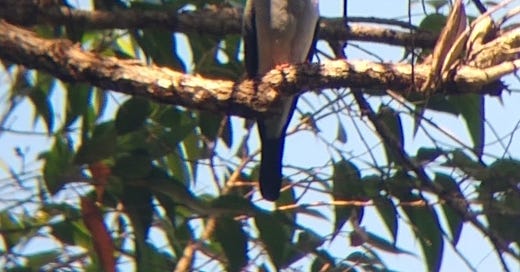


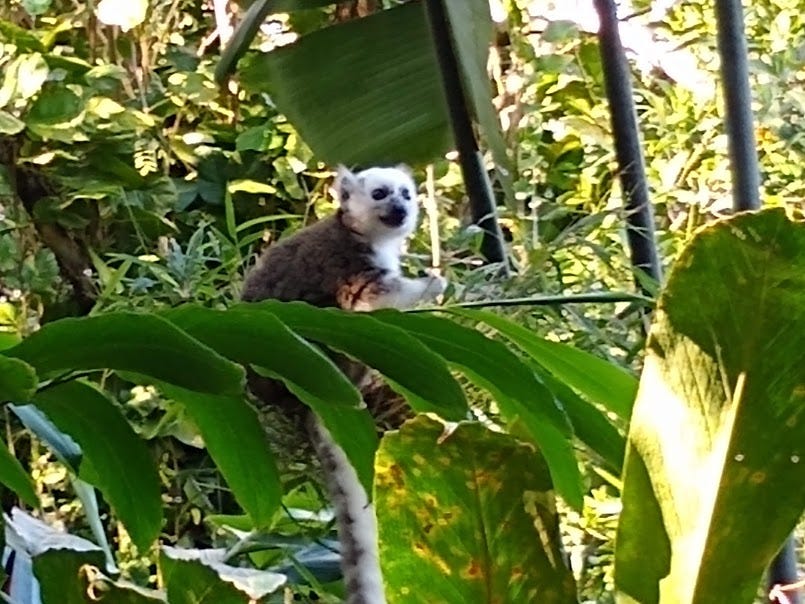

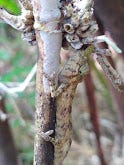




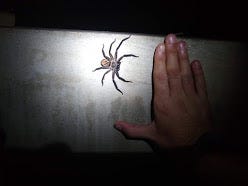
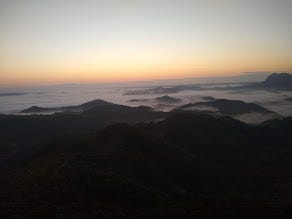
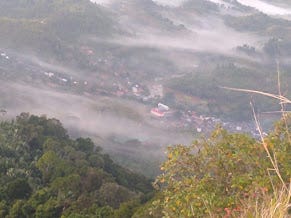

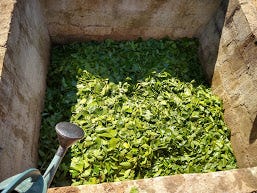

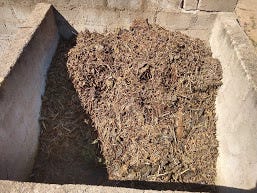
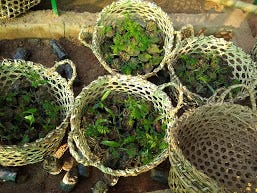
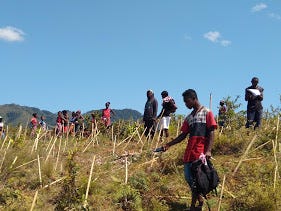

Simply wonderful! These blog posts are precious.. both fun , evocative, highly informative, eye-opening, and deeply admirable...worthy of being published in book form. Get an agent, Sam!
I loved the Clara Barton (possibly?) quote about a world view and a universe dying with every fallen soldier on the battlefield, but I love how you tied it to Nature more. All our efforts are exercises in futility and self-delusion, especially compared to those of Nature, and I'm reminded of the fact that each tapestry is composed of singular threads: the more healthy and vibrant each thread is, the more beautiful the tapestry is. MAN! Did Nature ever get that tapestry right! Great piece.